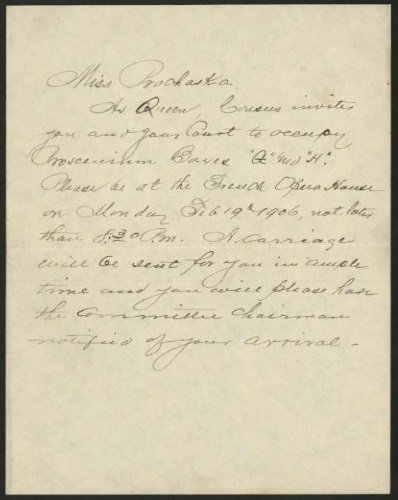Aline Prochaska: The last Queen of Consus
The tableaux society Consus, named after the Roman god of secret counsel, lasted a scant decade; yet, both its birth and its demise are steeped in New Orleans Carnival lore. No records relating to the tableaux society have ever been donated to a research archives, thus making its history a challenge to share. Yet, a letter found in the Daniel R. Carroll Family papers, housed at LSU Libraries Special Collections, offers a glimpse into the last ball that Consus hosted.

This charming note from presumably Consus’s Captain to its last Queen, Aline Prochaska (Walsh), provides instructions for her arrival at the French Opera House on Monday, 19 February 1906. “A carriage will be sent for you in ample time and you will please have the committee chairman notified of your arrival--” Little did Ms. Prochaska know that the evening would end with angry women demanding that their escorts resign from the organization. Within days, Consus would go defunct.
A few things about Consus’s beginnings are known from newspaper accounts and recollections. The krewe sprang up in 1896, debuting its first ball in 1897, and filled its ranks with the sons of krewemen from older Carnival organizations such as Comus, Rex, Momus, and Proteus and family names such as Walmsley, Sloo, Dymond, Claiborne, Oxnard, Pitot, Fenner, Puig, and Rightor.
A month before its inaugural ball, members of the nascent krewe fought over who would be the first queen. This disagreement caused some members to resign and form another tableaux society, the High Priests of Mithras. For the 1897 season, Consus featured Stella Demouselle as its queen while Mithras welcomed Louise Joubert as theirs. Over ensuing years, both organizations would sport similar themes for their balls.
Considered a young man’s Carnival organization, Consus’s members sought to produce the most elaborate and technologically advanced balls ever seen in New Orleans society. An effect that Consus implemented in 1897 that would influence future tableaux centered on a fairly new technology to New Orleans—electrification: “One of the striking and almost startling effects of the stage setting was obtained by an electric fixture spelling out in blazing capitalized letters ‘Consus’.”[1]
Over the course of the next nine years, Consus developed a reputation for their elaborate tableaux, complete with not only electrification, calcium lights and incandescent lights, but also with its set designs, such as its replication of Versailles’s Hall of Mirrors during its 1899 season, complete with thousands of pieces of cut art glass lining the walls.
For its 1906 ball, organizers set out to outdo previous tableaux. The year’s theme, The Land of Frontinback and Upondown, set to reverse the heavens and the earth in its design: clouds billowed underfoot and forests and fields climbed toward the guests from the ceiling of the French Opera House. Maskers dressed in reverse—that is they sported their masks on the backs of their heads; their wigs, supplied with peepholes for the eyes, covered their faces; and maskers donned their costumes backwards. This costuming confused and dismayed indignant female guests who were offended at the prospect of facing men’s backs during call-outs. Perry Young, author of Mistick Krewe and an early chronicler of Carnival to write about Consus, concluded that these guests brought about Consus’s downfall: “So ended Consus, victim of his own cleverness, as the ladies promptly turned thumbs down, and resignations quickly reduced the famous society to a memory.”[2]
[1] Daily Picayune, February 13, 1897.
[2] Young, Perry The Mistick Krewe: Chronicles of Comus and His Kin (New Orleans: Louisiana Heritage Press, 1969).
